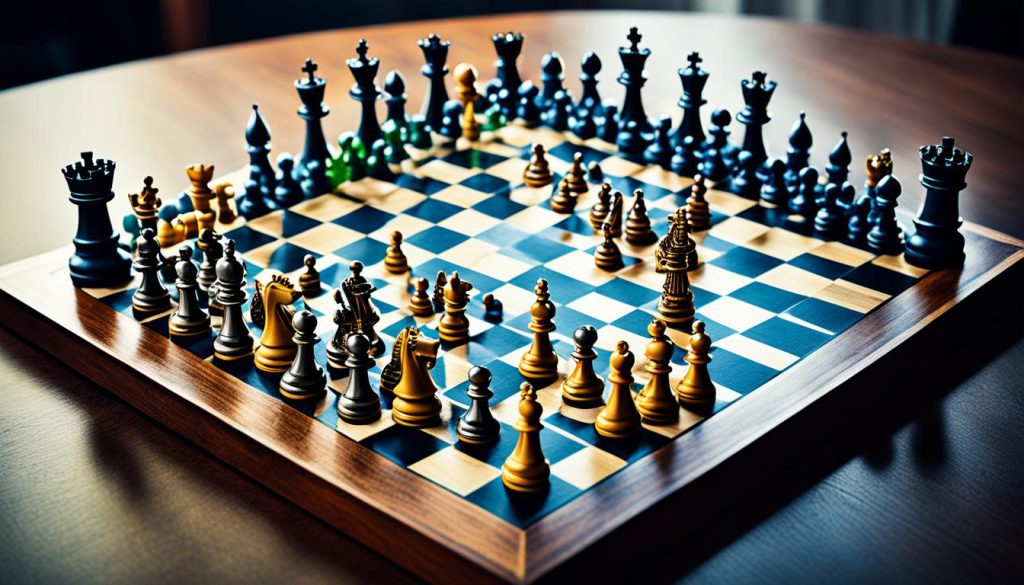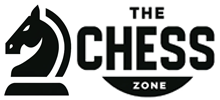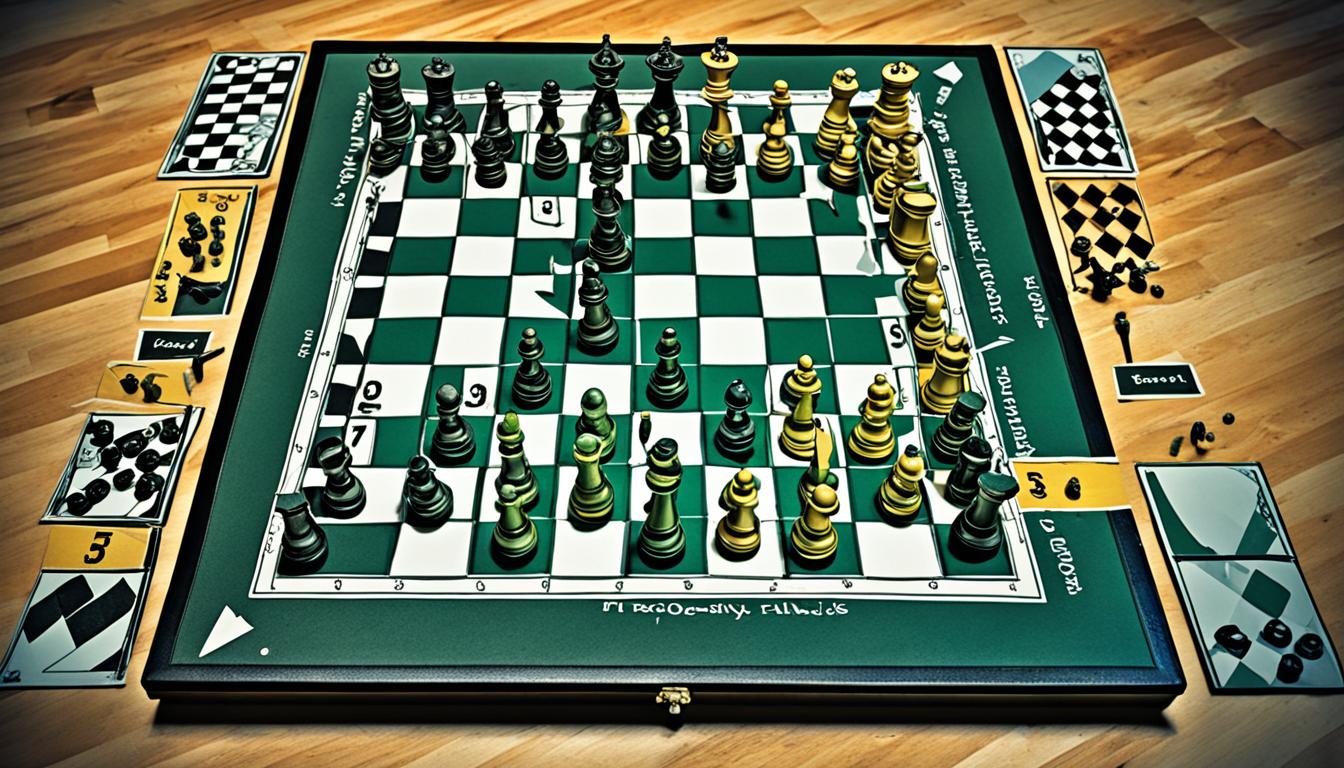Have you ever felt stuck in a chess game’s middle phase, despite trying your hardest? As someone who loves chess, I have discovered that the middle game is key to improving. It involves a strategic play of pieces that can lead to an advantage.
Learning about pawn structures, how to develop strategies, and taking control of the center can turn a likely loss into victory.
Chess expert Prasanna Kumar highlights the importance of middle game tactics. Through this article, we’ll dive into those crucial concepts. We’ll use real strategies and tactics to help players become better at the middle game.
Focus on pawn structures, protecting your king, or taking the initiative. Any one of these tactics can greatly improve your game.
Key Takeaways
- Understanding pawn structures can shift the nature of play in your favor.
- Effective development strategy leads to a temporary yet significant advantage when done harmoniously.
- Control of the center is crucial for guiding the game’s direction and should be prioritized.
- King safety is indispensable during the opening and middle game stages.
- Maintaining the initiative allows you to create threats and keep your opponent on the defensive.
Understanding Pawn Structures
Learning about chess pawn structures is essential for players wanting to get better at strategy and tactics. The arrangement of pawns sets the game’s tone, influencing both strategic plans and tactical moves.
Fixed Pawn Center
In the French Defense, a fixed pawn center is a classic scenario. White’s pawns at d4 and e5 face off against Black’s at e6 and d5. This creates a blocked center, turning the area into a strategic battleground for pieces.
This setup demands a good grasp of piece placement since advancing is tough.
Closed Pawn Center
Closed pawn centers shift the battle to the flanks. Take the French Defense, where Black’s setup can lead to side-focused play. In these scenarios, strategies must be subtle, as frontal attacks won’t work, encouraging moves to the sides.
Mobile Pawn Center
A mobile pawn center is characterized by its flexibility. It allows for dynamic piece play while limiting the opponent’s options. The player needs to find a balance between attacking and keeping their structure secure.
Dynamic Pawn Center
Dynamic centers adapt to changes in the game, pushing players to be proactive. An example is certain variations in the French Defense, highlighting the importance of tactical adaptability and seizing chances as they appear.
| Pawn Structure | Characteristics | Common Openings |
|---|---|---|
| Isolated Pawns | Severed from support, posing vulnerabilities but opening lines | Queen’s Gambit Accepted, Nimzo-Indian Defense |
| Carlsbad Structure | Mainstay in Queen’s Gambit Declined and Caro-Kann, typified by pawn majorities on the queenside | Queen’s Gambit Declined, Caro-Kann |
| Opposite-side Castling | Heated attacks on opposing kings, often seen in Sicilian Defense | Sicilian Defense, French Defense |
| Hanging Pawns | Offer dynamic play but require careful handling | Various Queen’s Pawn Openings |
Understanding these pawn structures deeply can improve your chess tactics and mid-game strategy. It lets you tailor your play style to match your strengths and preferences.
Effective Development Strategies
Developing pieces in a balanced way is key for top chess strategies in the middlegame. Early mistakes can lead to a chain reaction of problems. By focusing on these strategies, you can weave tactics seamlessly and strengthen your game.
Avoiding Disharmonious Development
All pieces working together marks a winning tactic in chess. Being out of sync can cause issues or leave pieces unused. It’s important that every piece backs up each other for a solid strategy.
Handling Greedy Captures
Going after quick gains can be tempting but risky. Snatching a piece without thinking of the bigger picture might set you back. Even though gaining material is good, always think of your overall game plan.
Executing Thoughtful Exchanges
Smart trades are vital in chess. Don’t swap pieces without a plan. Think about how each trade affects your position. Good exchanges can help control the center or free up your rooks, making your game stronger.
| Type of Development | Key Considerations |
|---|---|
| Harmonious Development | Ensures effective coordination of all pieces for a stronger middle game strategy. |
| Greedy Captures | Material gain should not compromise overall strategic play. |
| Thoughtful Exchanges | Strategic piece trades can lead to positional advantages and open lanes for attack. |
Steering clear of issues like disharmony, being cautious with captures, and making smart trades can boost your position and game. Using top chess strategies early sets you up for tactical moves that win.
Importance of Controlling the Center
Controlling the chess center hugely affects the game. When my pieces hit the center squares, my options grow. A piece that rules more center squares leads the game. This is not just a theory. It boosts my playing power.
It’s key to hold the center with pawns, especially on d4, d5, e4, and e5. This stronghold helps my pieces move freely and limits my rival. Fighting for space in the center boosts my attack creativity.
Beating enemy pieces in the center is vital for me. I often swap side pawns for central ones to keep control. In the middlegame, I focus on using this control for attacks.
Chess, loved by millions for ages, centers on this strategy. Mastering these moves betters my win chances in the middle game.
Ensuring King Safety
The safety of the king is crucial in chess. Players need to protect the king during the middlegame. Chess tactics often show how small mistakes in protecting the king can lead to big losses. Learning about king safety and looking at real games can help players defend better and boost their performance.
Principles of King Safety
Keeping the king safe should be your top priority in the middlegame. There are a few key principles for king security:
- Castling Early: Castling early gives the king a safe spot behind pawns.
- Pawn Shield: A strong pawn structure around the king stops enemy attacks.
- Piece Coordination: Pieces that work together well can protect the king strongly.
- Avoiding Weaknesses: Avoid moves that make pawns weak or expose the king.
Examples of Poor King Safety
Many games show what happens when the king isn’t protected well:
| Game | Example of Poor King Safety | Outcome |
|---|---|---|
| Kasparov vs. Karpov (1984) | Karpov didn’t castle early, leaving his king vulnerable. | Kasparov attacked successfully and won. |
| Fischer vs. Spassky (1972) | Spassky’s pawn structure around the king was weak. | Fischer used this to break through and win. |
Looking at these examples helps us grasp chess tactics better. We learn the importance of king safety in the middlegame. Good king safety is key to avoiding mistakes and winning the game.

Utilizing the Initiative
In chess, taking the initiative is key to leading a game that’s both aggressive and smart. This skill lets players control the game and make their opponent react to them. By getting good at chess moves, one can take over the game and create many chances to win.
Creating Threats
When you make chess threats, it’s like pushing your opponent into a tough spot. Grandmaster Lev Polugaevsky was a genius at this, showing how effective threats are in his games. His way of playing proves that thinking ahead to make your opponent make mistakes is crucial.
In a match against Petrosian, his use of threats led to a key victory. Learning from these tactics can shake up your opponent’s strategy and give you the upper hand.
Seizing the Initiative
To grab the initiative in chess needs sharp attention to detail and smart planning. Looking at Polugaevsky’s play against Boris Gelfand shows how. He mixed strategic moves with clear tactics to trouble the opponent greatly.
Even small weaknesses were exploited to swing the game in his favor. Such tactics highlight the power of staying on the offensive in chess.
| Challenge Type | Number of Challenges |
|---|---|
| Utilizing the Initiative | 17 |
| Total Challenges | 37 |
Making consistent threats and grabbing the initiative can change a game’s direction. This approach helps turn possible risks into surefire plans to win.
The Art of Attacking in Chess
Knowing how to attack in chess is key for getting ahead of others. A good attack can totally change the game. It turns your play from defensive to winning aggressively.
Identifying Targets
Chess middle game tactics start with finding important targets of your opponent. Vladimir Vukovic’s book “Art of Attack in Chess” gives detailed insights on this. It teaches how to focus on the castled king. The book is rich with examples over its 350 pages, diving deep into attack strategies.
Vukovic talks about setting up for a successful attack. He mentions controlling the center and stopping the opponent’s counterattacks. It’s also about placing your pieces right and making the other player’s defense weak.
Calculating Attack Success
Getting your attacks right in chess needs precise calculation. Vukovic says to look at the attackers versus defenders ratio. A two-to-one ratio usually means a good chance for success. John Nunn added his thoughts and corrections to Vukovic’s work. His input helps players navigate through complex game moments.
Vukovic also explores when and where to castle your king. This choice is crucial in your game plan for the middle game. His advice points to making smart decisions on castling. These tips help players improve their attack tactics.
| Author | Book | Focus | Additional Contributions |
|---|---|---|---|
| Vladimir Vukovic | Art of Attack in Chess | Attacking the Castled King | John Nunn’s Commentary & Corrections |
| Zenon Franco | The Art of Attacking Chess | Attacking Chess with Annotated Games | 33 Model Games and Effective Diagrams |
With advice like this, players can use chess middle game tactics well. They can plan and carry out strong attacks. This way, they can beat their opponents and win games.
Advanced Defense Techniques
Chess isn’t just about attacking. Mastering defense is also key to winning. Knowing how to defend well includes understanding counterplay and prophylaxis. Chess experts say these skills are crucial for coming out on top in tough spots.
Types of Defense
Different defense strategies are essential for chess success:
- Passive Defense: This means strengthening key areas and building a solid defense without attacking back right away.
- Active Defense: Here, you counter your opponent’s threats head-on to mess up their plans.
- Prophylactic Defense: This strategy stops the opponent’s moves in their tracks before they can advance.
- Counterplay: You use tactical moves to shake up the opponent’s strategy. This can make them reconsider their attack.
Examples of Effective Defense
Top chess matches show how useful advanced defense techniques are. Look at these examples:
- Carlsen’s Nimble Defense: Magnus Carlsen turns weak spots into strengths with active and prophylactic defense. He shows the power of staying strong under pressure.
- Kasparov’s Counterplay: Garry Kasparov was a master at counterplay. He made moves that flipped his opponents’ plans on their heads.
By studying these moves and using tactical chess strategies from famous games, you can learn a lot. These techniques can really help you win.
| Key Concepts | Examples |
|---|---|
| Passive Defense | Queen’s Gambit Declined |
| Active Defense | Sicilian Defense |
| Prophylactic Defense | Petroff Defense |
| Counterplay | Modern Benoni Defense |
Chess.com is a great place to get better at defense. It has Chess Mentor courses and Tactics Trainer. These tools are great for learning advanced chess tactics and practicing defensive positions. They can help you level up from beginner to advanced.
The Transition from Middlegame to Endgame
Moving from the middlegame to the endgame is an art. It needs a sharp eye to judge endgame positions. This stage changes the game from active pieces to careful planning. Knowing when to shift is crucial for success. Swapping pieces to simplify the game is often key, especially if it gives you an upper hand.
It’s vital to understand pawn structures here. Building a strong pawn setup while weakening your opponent’s is useful. Passed pawns are a big deal because they can become queens and lead to victory. The importance of pawns and their queening potential is huge.
When to Transition
Choosing to enter the endgame depends on material count. Being ahead means it’s a good move to transition. But if you’re trailing, staying away from trading pieces might be smarter. Still, it all depends on the pawns and the situation.
In a tie, the complexity of the situation matters. Keeping the game unpredictable can help avoid draws and find advantages. Also, certain endgames like those with bishops of opposite colors can change the game’s outcome.
Evaluating Endgame Positions
Evaluating endgames needs a deep knowledge of endgame rules. Think about how active your king is and what your pawns can do. An active king can turn a game, especially with pawns. Rooks and bishops also have unique advantages based on the pawn layout.
Being sharp with tactics is crucial now. It helps find chances for simplifying the game or setting traps. Sometimes, sacrificing material for active pieces is a smart move.
In the end, shifting from middlegame to endgame needs both tactics and strategy. Getting good at this improves your game and lets you see chess’s beauty.
The Role of Tactics in Chess Middle Game Tactics
The middlegame in chess combines strategy and tactics. Chess master Siegbert Tarrasch says the middlegame is crucial. Most games are won or drawn in this phase.
In the middlegame, using tactics like skewers, forks, and pins is key. These moves turn small advantages into big wins. Players should watch their and their opponent’s moves closely, looking for chances to strike.
“After a bad opening, there is hope for the middle game.” — Grandmaster Edmar Mednis
Tactics are vital in the middlegame to get better at chess. This part of the game values creativity more than knowing a lot of moves. Experts advise moving knights and bishops to control the board. The Queen should be used for attack and defense.
Keeping an eye on your pieces and pawns shapes a strong game. Avoid weak spots and watch out for vulnerable pawns. Knowing middlegame strategies leads to a smooth transition to the endgame.
- Centralizing knights and bishops increases maneuverability.
- Utilizing the Queen as a dual-purpose piece enhances both offense and defense.
- Connecting rooks on the same file is crucial for backup and preparation for rook endgames.
- Maintaining pressure by capturing or chasing the opponent’s pieces prevents them from gaining the upper hand.
Reviewing your position well involves looking at material count, pawn setup, and king safety. Pay attention to piece placement. Focusing on these will deepen your tactical skill, leading to more winning chess tactics.
Conclusion
The journey of mastering chess, especially the middlegame, mixes strategic planning with sharp tactics. This stage is often where games are decided due to its complexity. Chess middlegame knowledge is key for winning or drawing later on. In this vital phase, being creative is more important than just remembering past games.
Players should know that material and pawns matter a lot in their strategy. Focusing on these can help choose the best moves. During the middlegame, tactics like the double attack are very important. This stage starts when both sides are developed and have castled, marking the intricate battle of pieces that comes next.
I’ve learned how controlling the center and keeping pieces active are essential. The middlegame starts after openings end and when detailed plans are needed. It shifts to the endgame when many pieces are off the board. This article, with insights from experts like Prasanna Kumar, shows the importance of learning these tactics to grow as a player.
Source Links
- https://thechessworld.com/articles/middle-game/9-middlegame-concepts-you-must-know/
- https://thechessworld.com/articles/middle-game/pawn-structures/
- https://thechessworld.com/articles/middle-game/10-must-know-middlegames-for-club-players/
- https://chess-teacher.com/8-pawn-structures-you-must-know/
- https://enthu.com/blog/chess/chess-middlegame/
- https://www.chess.com/article/view/must-know-middlegame
- https://www.chess.com/blog/Gertsog/how-to-control-the-center-and-why-its-important
- https://summitschoolofchess.com/mastering-the-chess-middlegame-strategies-for-success/
- https://royalchessmall.com/blogs/blog/chess-middlegame
- https://chessmood.com/blog/maintaining-a-strategic-initiative-in-chess
- https://www.chess.com/lessons/the-essence-of-the-initiative
- https://www.chess.com/article/view/book-review-art-of-attack-in-chess
- https://chessentials.com/the-art-of-attacking-chess/
- https://pawnbreak.com/how-to-transition-from-middlegame-to-endgame/
- https://www.reddit.com/r/chess/comments/oq3cn9/tips_endgame_middletoendgame_transition/
- https://www.chessstrategyonline.com/content/tutorials/basic-chess-concepts-phases-of-the-game
- https://www.chess.com/terms/chess-middlegame
- https://thechessworld.com/articles/middle-game/chess-strategy-what-do-you-need-to-know-about-strategy-and-tactics/

